| Article ID | Journal | Published Year | Pages | File Type |
|---|---|---|---|---|
| 7429046 | International Journal of Information Management | 2018 | 15 Pages |
Abstract
Herding in open platform adoption decisions appears to prevail even when the systems adopted represent high risks with enterprise-wide impact. We present a model of organizational open platform adoption that integrates six different theoretical mechanisms based on a technology-organization-environment framework that drives herding: network effect benefits, new platform benefits, new platform risk, organizational learning, mimetic pressures, and competitive pressures. To find which mechanisms work significantly in organizational IT decision-making in accordance with IT diffusion and rival precedence, we empirically test the model by splitting the samples according to the proportion of rivals that have already adopted innovations. The empirical results demonstrate that among the six herding mechanisms, new platform risk and organizational learning drives herding in the earlier stage of diffusion and new platform benefits and competitive pressure drives herding in the later stage of diffusion. The results imply that organizations react conservatively to new platforms when they perceive less platform diffusion. However, as diffusion increases, organizations react more strategically to maintain competitive parity with rivals by imitating rival decisions.
Related Topics
Social Sciences and Humanities
Business, Management and Accounting
Management Information Systems
Authors
Seonyoung Shim, Byungtae Lee, Sojung Lucia Kim,
